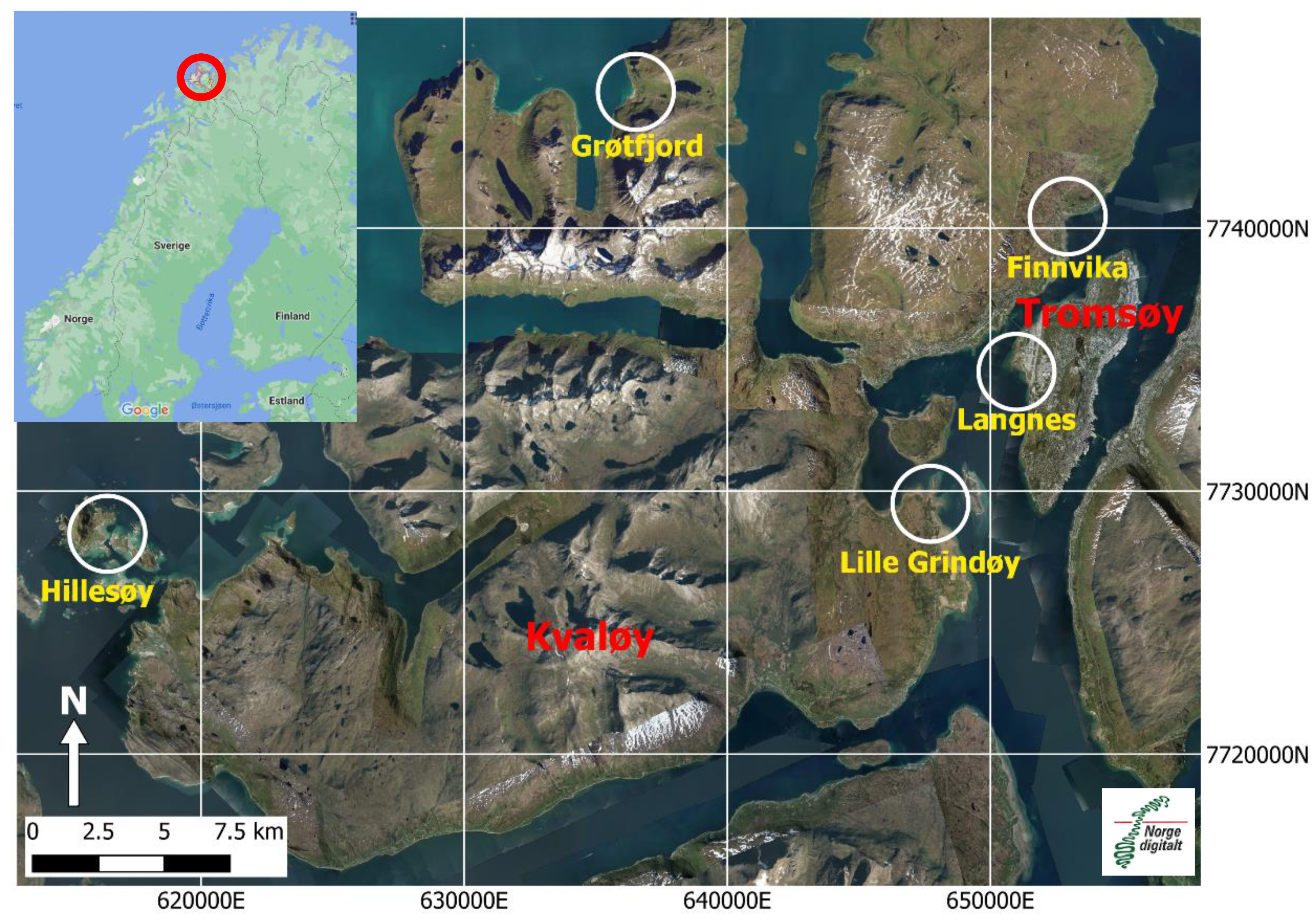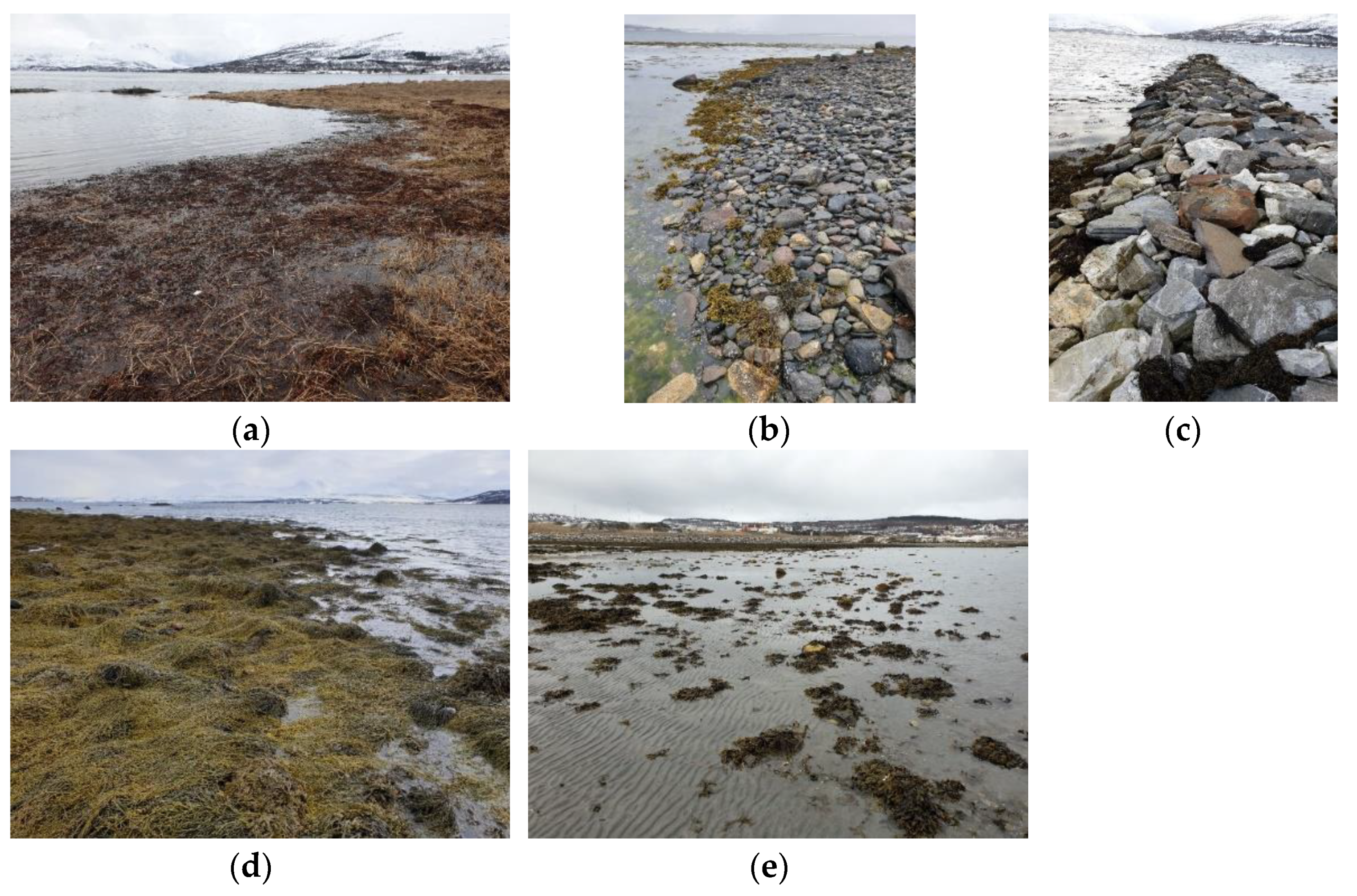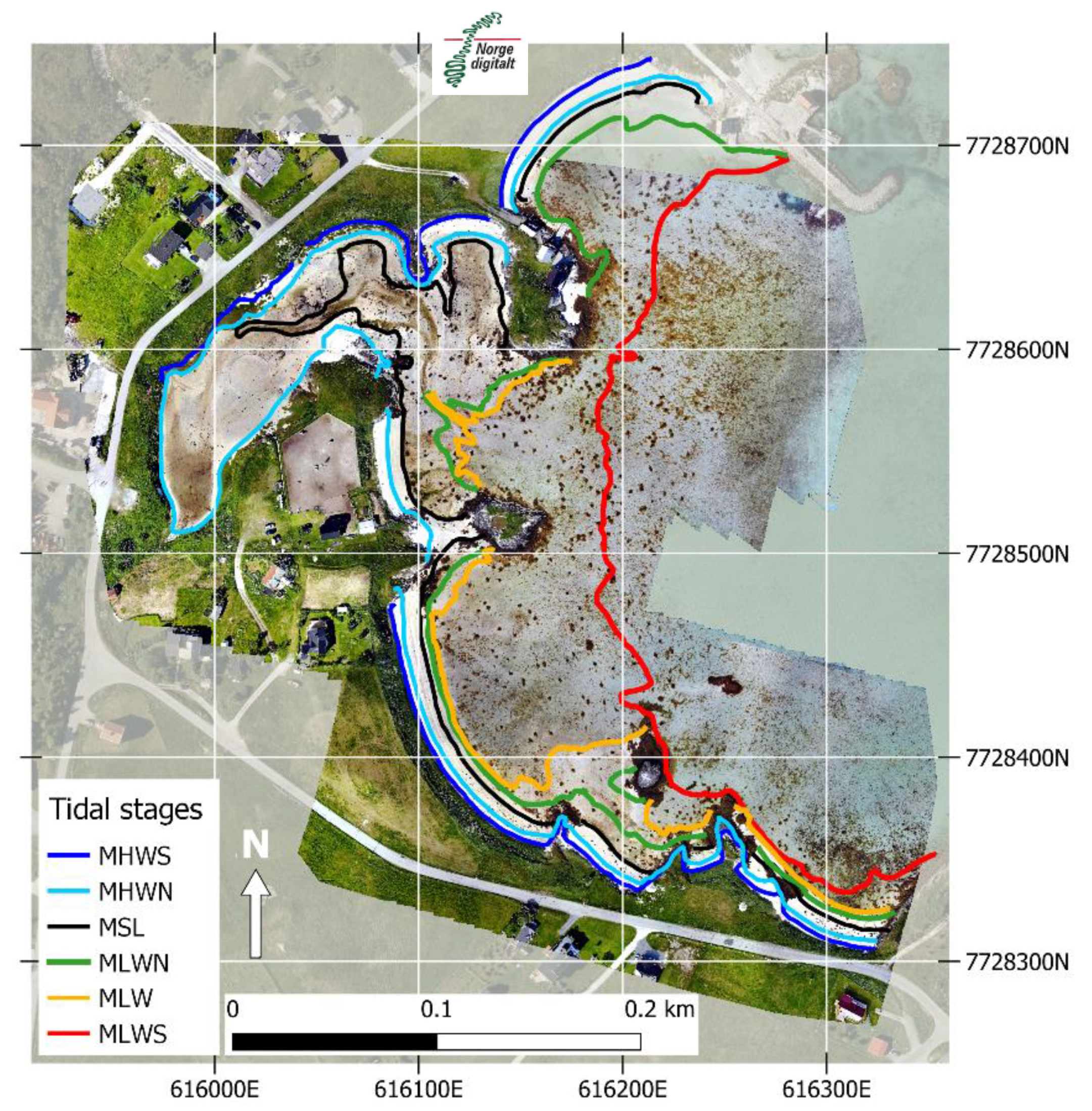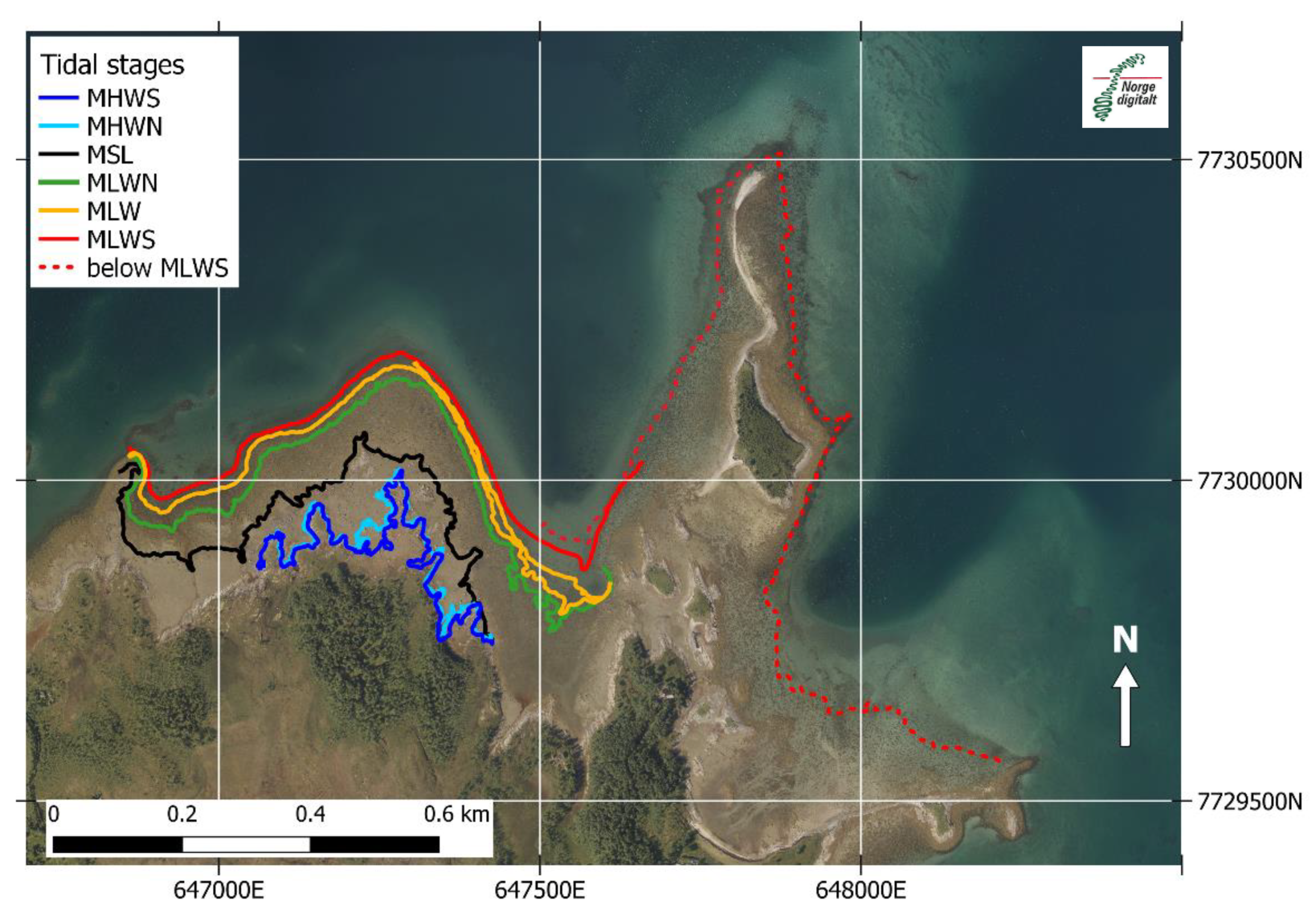Mapping Atmospheric Exposure of the Intertidal Zone with Sentinel-1 CSAR in Northern Norway
Abstract
:1. Introduction
2. Materials and Methods
2.1. Data
2.1.1. Study Area and Field Data Sites
2.1.2. Sentinel-1 C-Band Synthetic Aperture Radar Satellite Data
2.1.3. Tides and Sea-Level Data
- HAT—the highest astronomical tide (167 cm): the highest tide which can be predicted to occur (note that meteorological conditions may add extra height to the HAT),
- MHWS—mean high water springs (119 cm): the average of the two high tides on the days of spring tides,
- MHW—mean high water (90 cm): the average of all high water,
- MHWN—mean high water neaps (61 cm): the average of the two high tides on the days of neap tides.
- MSL—Mean sea level (0 cm): the average sea level for the period 1996–2014,
- MLWN—mean low water neaps (−60 cm),
- MLW—mean low water (−90 cm),
- MLWS—mean low water springs (−119 cm),
- LAT—the lowest astronomical tide (−174 cm) [11].
2.1.4. Aerial Photo Mosaics
2.2. Methods
2.2.1. Sentinel-1 Preprocessing and Slope Correction
2.2.2. Statistical Analysis and Mapping Atmospheric Exposure
2.2.3. In Situ Data Collection
- Langnes
- Hillesøy
- Lille Grindøy
- Finnvika and Grøttfjord
2.2.4. Algorithm Training and Validation
3. Results
3.1. Percentage of Atmospheric Exposure Product
3.2. Accuracy Assessment
3.3. Misclassification Errors
4. Discussion
5. Conclusions
Author Contributions
Funding
Institutional Review Board Statement
Informed Consent Statement
Data Availability Statement
Acknowledgments
Conflicts of Interest
References
- NOAA. What Is the Intertidal Zone? Available online: https://oceanservice.noaa.gov/facts/intertidal-zone.html (accessed on 27 June 2021).
- Murray, N.J.; Keith, D.A.; Bland, L.M.; Ferrari, R.; Lyons, M.B.; Lucas, R.; Pettorelli, N.; Nicholson, E. The role of satellite remote sensing in structured ecosystem risk assessments. Sci. Total Environ. 2018, 619–620, 249–257. [Google Scholar] [CrossRef] [Green Version]
- Macreadie, P.I.; Anton, A.; Raven, J.A.; Beaumont, N.; Connolly, R.M.; Friess, D.A.; Duarte, C.M. The future of Blue Carbon science. Nat. Commun. 2019, 10, 3998. [Google Scholar] [CrossRef] [Green Version]
- Biology Dictionary. Intertidal Zone. Available online: https://biologydictionary.net/intertidal-zone/ (accessed on 21 June 2021).
- IPBES. Summary for Policymakers of the Global Assessment Report on Biodiversity and Ecosystem Services of the Intergovernmental Science-Policy Platform on Biodiversity and Ecosystem Services; Díaz, S., Settele, J., Brondízio, E.S., Ngo, H.T., Guèze, M., Agard, J., Arneth, A., Balvanera, P., Brauman, K.A., Butchart, S.H.M., et al., Eds.; Intergovernmental Science-Policy Platform on Biodiversity and Ecosystem Services (IPBES) Secretariat: Bonn, Germany, 2019. [Google Scholar]
- Vesterbukt, P.; Aune, S.; Grenne, S.; Johansen, L. Basiskartlegging etter NiN (Naturtyper i Norge) i 10 utvalgte verneområder i Østfold. Resultater. Bioforsk Rapp. 2013, 8, 79, ISBN 978-82-17-01096-8. [Google Scholar]
- Hanssen-Bauer, I.; Førland, E.J.; Haddeland, I.; Hisdal, H.; Lawrence, D.; Mayer, S.; Nesje, A.; Nilsen, J.E.Ø.; Sandven, S.; Sandø, A.B.; et al. Climate in Norway 2100—A knowledge base for climate adaptation. In NCCS Report NO. 1/2017, Norwegian Environmental Agency Report M-741; Norwegian Centre for Climate Services (NCSC): Bergen, Norway, 2017; p. 48. [Google Scholar]
- Regjeringen.no. Seas and Coastlines—The Need to Safeguard Species Diversity. Available online: https://www.regjeringen.no/en/topics/climate-and-environment/biodiversity/innsiktsartikler-naturmangfold/hav-og-kyst/id2076396/ (accessed on 1 July 2021).
- Lundberg, A. Havstrandnatur. Tilstand, Overvåking. In DN-Utredning 6–2013; Direktoratet for Naturforvaltning: Trondheim, Norway, 2013; ISBN 978-82-8284-105-4. [Google Scholar]
- Olsen, M. Salt Marshes in the Nordic Region. Webinar on Salt Marshes in the Nordic Region. 8 June 2021. Available online: https://www.dropbox.com/s/unf5s9h5woqn7tf/Salt%20Marshes%20in%20The%20Nordic%20Region%20-%20Webinar-20210608_120243-Opptak%20av%20m%C3%B8te.mp4?dl=0 (accessed on 1 July 2021).
- Wikipedia. Tide. Available online: https://en.wikipedia.org/wiki/Tide (accessed on 27 June 2021).
- Kartverket. Se Havnivå. Available online: https://www.kartverket.no/en/at-sea/se-havniva (accessed on 21 June 2021).
- Norwegian Biodiversity Information Centre. Available online: https://www.biodiversity.no/ (accessed on 1 July 2021).
- Artsdatabanken. Available online: https://www.artsdatabanken.no/ (accessed on 1 July 2021).
- Aarninkhof, S.G.; Turner, I.L.; Dronkers, T.D.; Caljouw, M.; Nipius, L. A video-based technique for mapping intertidal beach bathymetry. Coast. Eng. 2003, 49, 275–289. [Google Scholar] [CrossRef]
- Sobral, F.; Pereira, P.; Cavalcanti, P.; Guedes, R.; Calliari, L. Intertidal bathymetry estimation using video images on a dissipative beach. J. Coast. Res. 2013, 65, 1439–1444. [Google Scholar] [CrossRef]
- Bell, P.S.; Bird, C.O.; Plater, A.J. A temporal waterline approach to mapping intertidal areas using X-band marine radar. Coast. Eng. 2016, 107, 84–101. [Google Scholar] [CrossRef] [Green Version]
- Kumar, D.; Takewaka, S. Automatic shoreline position and intertidal foreshore slope detection from X-Band radar images using modified Temporal Waterline Method with corrected wave run-up. J. Mar. Sci. Eng. 2019, 7, 45. [Google Scholar] [CrossRef] [Green Version]
- Guenther, G.C.; Brooks, M.W.; LaRocque, P.E. New capabilities of the “SHOALS” airborne LiDAR bathymeter. Remote Sens. Environ. 2000, 73, 247–255. [Google Scholar] [CrossRef]
- ESA. The European Space Agency—Sentinel. Available online: https://sentinel.esa.int/web/sentinel/home (accessed on 21 June 2021).
- Copernicus Land Monitoring Service. Coastal Zones. Available online: https://land.copernicus.eu/local/coastal-zones (accessed on 21 June 2021).
- Davidson, N.C.; Finlayson, C.M. Updating global coastal wetland areas presented in Davidson and Finlayson (2018). Mar. Freshw. Res. 2019, 70, 1195–1200. [Google Scholar] [CrossRef]
- Rebelo, L.-M.; Finlayson, C.M.; Strauch, A.; Rosenqvist, A.; Perennou, C.; Tøttrup, C.; Hilarides, L.; Paganini, M.; Wielaard, N.; Siegert, F.; et al. The use of Earth Observation for wetland inventory, assessment and monitoring: An information source for the Ramsar Convention on Wetlands. In Ramsar Technical Report; Ramsar Convention Secretariat: Gland, Switzerland, 2018; p. 31. [Google Scholar]
- Murray, N.J.; Phinn, S.R.; DeWitt, M.; Ferrari, R.; Johnston, R.; Lyons, M.B.; Clinton, N.; Thau, D.; Fuller, R.A. The global distribution and trajectory of tidal flats. Nature 2019, 565, 222–225. [Google Scholar] [CrossRef] [PubMed]
- Sagar, S.; Roberts, D.; Bala, B.; Lymburner, L. Extracting the intertidal extent and topography of the Australian coastline from a 28 year time series of Landsat observations. Remote Sens. Environ. 2017, 195, 153–169. [Google Scholar] [CrossRef]
- Haarpaintner, J.; Davids, C. Satellite Based Intertidal-Zone Mapping from Sentinel-1&2. Final Report. In NORCE Klima Report 2-2020, Norwegian Environment Agency Report M-1646; NORCE—Norwegian Research Centre AS: Bergen, Norway, 2020; Available online: https://www.miljodirektoratet.no/publikasjoner/2020/mars-2020/satellite-based-intertidal-zone-mapping-from-sentinel-12/ (accessed on 24 August 2021).
- Zhao, C.; Qin, C.-Z.; Teng, J. Mapping large-area tidal flats without the dependence on tidal elevations: A case study of Southern China. ISPRS J. Photogramm. Remote Sens. 2020, 159, 256–270. [Google Scholar] [CrossRef]
- Mason, D.C.; Davenport, I.J.; Robinson, G.J.; Flather, R.A.; Mccartney, B.S. Construction of an inter-tidal digital elevation model by the “water-line” method. Geophys. Res. Lett. 1995, 22, 3187–3190. [Google Scholar] [CrossRef]
- Heygster, G.; Dannenberg, J.; Notholt, J. Topographic mapping of the German tidal flats analyzing SAR images with the waterline method. IEEE Trans. Geosci. Rem. Sens. 2010, 48, 1019–1030. [Google Scholar] [CrossRef]
- Tong, S.S.; Deroin, J.P.; Pham, T.L. An optimal waterline approach for studying tidal flat morphological changes using remote sensing data: A case of the northern coast of Vietnam. Estuar. Coast Shelf Sci. 2020, 236, 106613. [Google Scholar] [CrossRef]
- Wang, Y. Satellite SAR Imagery for Topographic Mapping of the Tidal Flat Areas in the Dutch Wadden Sea. Ph.D. Thesis, ITC, Enschede, The Netherlands, 1997. [Google Scholar]
- Mason, D.C.; Davenport, I.J. Accurate and efficient determination of the shoreline in ERS-1 SAR images. IEEE Trans. Geosci. Remote Sens. 1996, 34, 1243–1253. [Google Scholar] [CrossRef]
- ESA. Sentinel-1. Available online: https://sentinel.esa.int/web/sentinel/missions/sentinel-1 (accessed on 21 June 2021).
- Copernicus Open Access Hub. Available online: https://scihub.copernicus.eu/ (accessed on 21 June 2021).
- Alaska Satellite Facility. Available online: https://vertex.daac.asf.alaska.edu/# (accessed on 21 June 2021).
- Norgeibilder. Available online: https://norgeibilder.no/ (accessed on 27 June 2021).
- Davids, C.; Haarpaintner, J. Mapping intertidal zones using time series of Sentinel-2. Remote Sens. 2021. under review. [Google Scholar]
- Larsen, Y.; Engen, G.; Lauknes, T.R.; Malnes, E.; Høgda, K.A. A generic differential InSAR processing system, with applications to land subsidence and SWE retrieval. In Proceedings of the ESA FRINGE Workshop, ESA ESRIN. Frascati, Italy, 28 November–2 December 2005. [Google Scholar]
- Ulander, L. Radiometric slope correction of synthetic aperture radar images. IEEE Trans. Geosci. Remote Sens. 1996, 34, 1115–1122. [Google Scholar] [CrossRef]
- ESA. Science Toolbox Exploitation Platform—SNAP Download. Available online: http://step.esa.int/main/download/snap-download/ (accessed on 21 June 2021).
- Google Earth Engine. Available online: https://earthengine.google.com/ (accessed on 21 June 2021).
- Gorelick, N.; Hancher, M.; Dixon, M.; Ilyushchenko, S.; Thau, D.; Moore, R. Google Earth Engine: Planetary-scale geospatial analysis for everyone. Remote Sens. Environ. 2017, 202, 18–27. [Google Scholar] [CrossRef]
- Mahoney, C.; Merchant, M.; Boychuk, L.; Hopkinson, C.; Brisco, B. Automated SAR Image Thresholds for Water Mask Production in Alberta’s Boreal Region. Remote Sens. 2020, 12, 2223. [Google Scholar] [CrossRef]
- Otsu, N. A threshold selection method from gray-level histograms. IEEE Trans. Syst. Man Cybern. 1979, 9, 62–66. [Google Scholar] [CrossRef] [Green Version]
- De Zan, F.; Guarnieri, A.M. TOPSAR: Terrain Observation by Progressive Scans. IEEE Trans. Geosci. Rem. Sens. 2006, 44, 2352–2360. [Google Scholar] [CrossRef]
- Pix4D. Measure from Images. Available online: https://www.pix4d.com/ (accessed on 21 June 2021).
- Ramsar Convention on Wetlands of International Importance Especially as Waterfowl Habitat. Available online: https://www.ramsar.org/documents (accessed on 27 June 2021).
- Ramsar Sites Information Service. Balsfjord Wetland System. Available online: https://rsis.ramsar.org/ris/1186 (accessed on 27 June 2021).
- Haarpaintner, J.; Davids, C.; Hindberg, H.; Arntzen, I.; Borch, N. Satellite-Based National Intertidal-Zone Mapping of Continental Norway with Sentinel-1&2. In NORCE Klima Report 1-2021, Norwegian Environment Agency Report M-1994; NORCE—Norwegian Research Centre AS: Bergen, Norway, 2021. [Google Scholar]
- Salameh, E.; Frappart, F.; Turki, I.; Laignel, B. Intertidal topography mapping using the waterline method from Sentinel-1 & -2 images: The examples of Arcachon and Veys Bays in France. ISPRS J. Photogramm. Remote Sens. 2020, 163, 98–120. [Google Scholar] [CrossRef]
- Borgersen, G.; Rinde, E.; Moy, S.; Gunderden, H. NIVA. Har vi “saltmarshes” i Norge? En Vurdering av Begrepet opp mot Norske Naturtyper. In NIVA Report 7558-2020, Norwegian Environment Agency Report M-1858; Norwegian Institute for Water Research: Oslo, Norway, 2020; Available online: https://www.miljodirektoratet.no/publikasjoner/2020/desember-2020/har-vi-saltmarshes-i-norge/ (accessed on 24 August 2021).
- Copernicus Land Monitoring Service. Coastal Zones Production of Very High Resolution Land Cover/Land Use Dataset for Coastal Zones of the Reference Years 2012 and 2018. Nomenclature Guideline. Available online: https://land.copernicus.eu/user-corner/technical-library/coastal-zone-monitoring (accessed on 24 August 2021).
- Oveland, I.; Norwegian Mapping Authority, Hønefoss, Norway. Personal communication, 2021.
















| Nr. | Date/Time | Satellite | Path | Direction |
|---|---|---|---|---|
| 1 | 1 August 2019; 16:16 | S1A | 131 | ASC |
| 2 | 2 August 2019; 16:07 | S1B | 058 | ASC |
| 3 | 3 August 2019; 05:28 | S1B | 066 | DES |
| 4 | 3 August 2019; 16:00 | S1A | 160 | ASC |
| 5 | 4 August 2019; 05:20 | S1A | 168 | DES |
| 6 | 5 August 2019; 05:12 | S1B | 095 | DES |
| 7 | 7 August 2019; 16:15 | S1B | 131 | ASC |
| 8 | 8 August 2019; 16:07 | S1A | 058 | ASC |
| 9 | 9 August 2019; 05:29 | S1A | 066 | DES |
| 10 | 9 August 2019; 15:59 | S1B | 160 | ASC |
| 11 | 10 August 2019; 05:20 | S1B | 168 | DES |
| 12 | 11 August 2019; 05:12 | S1A | 095 | DES |
| 2% | 5% | 25% | 50% | 75% | 95% | 98% | |
| γ°(VV) | −18.0 | −17.3 | −15.0 | −14.5 | −12.7 | −8.5 | −6.4 |
| γ°(VH) | −22.0 | −22.0 | −22.0 | −21.7 | −20.7 | −19.8 | −18.5 |
| Class | Color Code | Pixel Values |
|---|---|---|
| No data | (255,255,255) | 255 |
| Land (DEM > 50 cm) | (0,0,0) | 8 |
| Land (mask from S1) | (139,69,19) | 7 |
| >95% | (255,0,0) | 6 |
| 75-95% | (218,165,32) | 5 |
| 50-75% | (255,255,0) | 4 |
| 25-50% | (173,255,47) | 3 |
| 5-25% | (0,255,0) | 2 |
| <5% | (0,255,255) | 1 |
| Water | (0,0,255) | 0 |
| Time | Water Level (Pred.) (Ref. MSL) | Water Level (Obs.) (Ref. MSL) | Approx. Tidal Reference Level |
|---|---|---|---|
| 20:20–20:30 (6 June) | [−111 cm; −110 cm] | [−98 cm; −96 cm] | Minimum on 6 June |
| 20:45–20:54 | [−108 cm; −106 cm] | [−95 cm; −93 cm] | MLWS |
| 21:38–21:53 | [−87 cm; −76 cm] | [−74 cm; −62 cm] | MLW |
| 22:12–22:19 | [−65 cm; −59 cm] | [−51 cm; −45 cm] | MLWN |
| 23:09–23:27 | [−18 cm; −3 cm] | [−4 cm; +11 cm] | MSL |
| 23:59–00:08 | [+24 cm; +31 cm] | [+39 cm; +45 cm] | MHWN |
| 00:32–00:52 (7 June) | [+48 cm; +61 cm] | [+60 cm; +75 cm] | MHW |
| 01:08–01:25 | [+70 cm; +78 cm] | [+85 cm; +92 cm] | MHWS |
| Ground | Truth | (Pixels) | |||||||||
|---|---|---|---|---|---|---|---|---|---|---|---|
| Class | MinLWS | MLWS | MLW | MLWN | MSL | MHWN | MHW | MHWS | Total | User Acc. | |
| Water | 120 | 378 | 82 | 25 | 5 | 3 | 0 | 0 | 613 | ||
| <5% | 11 | 105 | 26 | 1 | 1 | 1 | 1 | 0 | 146 | 79% | |
| 5–25% | 62 | 395 | 117 | 25 | 16 | 3 | 2 | 2 | 622 | 86% | |
| 25–50% | 27 | 122 | 196 | 186 | 99 | 1 | 6 | 5 | 642 | 44% | |
| 50–75% | 6 | 51 | 83 | 88 | 406 | 52 | 45 | 27 | 758 | 60% | |
| 75–95% | 0 | 9 | 13 | 4 | 36 | 49 | 27 | 32 | 170 | 64% | |
| 95–99% | 0 | 0 | 0 | 1 | 3 | 15 | 17 | 5 | 41 | 54% | |
| S1 Land | 0 | 1 | 7 | 7 | 17 | 108 | 211 | 99 | 450 | 22% | |
| DEM > 50 cm | 0 | 0 | 3 | 3 | 4 | 14 | 43 | 150 | 217 | 69% | |
| Total | 226 | 1061 | 524 | 337 | 583 | 232 | 309 | 170 | 3442 | ||
| Prod. Acc. | 32% | 47% | 22% | 63% | 87% | 44% | 9% | 80% | |||
| ITZ area acc. | 47% | 64% | 84% | 93% | 99% | 99% | 100% | 100% |
Publisher’s Note: MDPI stays neutral with regard to jurisdictional claims in published maps and institutional affiliations. |
© 2021 by the authors. Licensee MDPI, Basel, Switzerland. This article is an open access article distributed under the terms and conditions of the Creative Commons Attribution (CC BY) license (https://creativecommons.org/licenses/by/4.0/).
Share and Cite
Haarpaintner, J.; Davids, C. Mapping Atmospheric Exposure of the Intertidal Zone with Sentinel-1 CSAR in Northern Norway. Remote Sens. 2021, 13, 3354. https://doi.org/10.3390/rs13173354
Haarpaintner J, Davids C. Mapping Atmospheric Exposure of the Intertidal Zone with Sentinel-1 CSAR in Northern Norway. Remote Sensing. 2021; 13(17):3354. https://doi.org/10.3390/rs13173354
Chicago/Turabian StyleHaarpaintner, Jörg, and Corine Davids. 2021. "Mapping Atmospheric Exposure of the Intertidal Zone with Sentinel-1 CSAR in Northern Norway" Remote Sensing 13, no. 17: 3354. https://doi.org/10.3390/rs13173354
APA StyleHaarpaintner, J., & Davids, C. (2021). Mapping Atmospheric Exposure of the Intertidal Zone with Sentinel-1 CSAR in Northern Norway. Remote Sensing, 13(17), 3354. https://doi.org/10.3390/rs13173354






